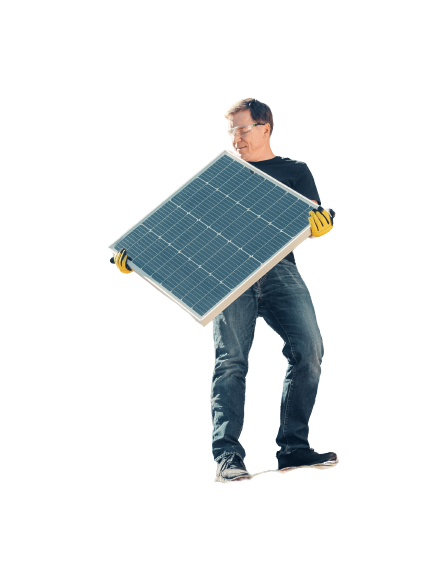Solar Energy Systems

Solar Energy Systems
olar Electrical Systems
Solar Electrical Systems Components
Solar energy is the main component of a solar electric power system. There are many types of solar energy on the market. Photovoltaic panels are another name for solar energy. A solar energy, also known as a solar module, is basically an array made up of parallel and series connected solar cells.
A solar cell’s potential difference is approximately 0.5 volt. Therefore, it is necessary to have a number of such cells connected in series to reach 14-18 volts to charge a 12 volt standard battery. To create a solar array, solar energy is connected together. To achieve higher current or higher voltage, multiple panels can be connected in series and parallel.
Batteries
Grid-tie solar generation systems have the solar modules connected directly to an inverter and not directly to the load. The power generated by the solar energy does not remain constant. It changes with the intensity of sunlight. Solar energy or modules do not directly feed electrical equipment. Instead, they are fed to an inverter, whose output is synchronized to external grid supply.
The inverter controls the frequency and voltage of the solar system’s output power. It always keeps it equal to the grid power level. The voltage level and quality are constant as we receive power from both the solar system and the external grid power supply system. The performance of electrical equipment that is fed by the grid fallback or stand-alone system cannot be affected by any variations in power levels.
It is necessary to have some way of maintaining the voltage and power supply rates of the system. This is done by a battery bank that is connected to the system. The solar electricity charges the battery and then it feeds a load either directly or via an inverter. This prevents variations in power quality caused by variation in sunlight intensity. Instead, an uninterrupted supply of power is maintained.
For this purpose, deep cycle lead acid batteries are usually used. These batteries can be charged and discharged multiple times during service. Most battery sets on the market are either 6 volts or 12 volts. To increase the voltage and current rating of the battery system, you can connect multiple of these batteries in parallel or series.
Controller
It is not a good idea to discharge and overcharge a lead-acid battery. Overcharging the battery too often or undercharging it can cause serious damage to the system. A controller must be attached to the system installed in order to prevent these two situations.
Inverter
It is evident that solar energy produces DC electricity. AC is the electricity we get from the grid. An inverter is needed to convert DC from complete solar system to AC at the same level as grid supply.
The inverter is connected directly to the battery terminals. This converts DC from the batteries to AC and then feeds the equipment. Grid tie system: The solar energy is connected directly to the inverter. This inverter then supplies the grid with the same voltage and frequency power.
Solar Energy Panels
Solar energy captures sunlight as clean renewable energy and converts it into electricity that can be used to power electrical loads. Solar energy consists of several individual solar cells that are composed of layers of silicon (which provides the negative charge) and phosphorus (which gives off the positive charge). Photons are absorbed by solar energy, which in turn create an electric current. Photons hitting the solar energy’s surface generate energy that allows electrons to escape their atomic orbits. This energy is then released into an electric field by the solar cells, which pulls these electrons into a direction current. The Photovoltaic Effect is the name of this entire process. The average home has enough roof space to support enough solar energy to generate enough electricity to power all its needs. Any excess electricity generated is sent to the main power grid and pays off in electricity consumption at night.
A solar array can generate power on the day when it is connected to the grid. This energy is then used at night. Solar generator owners can get paid through net metering programs if their system generates more power than is used in the home. A battery bank, charge controller, inverter, and charger are all required components for off-grid solar systems. The charge controller sends direct current (DC), electricity to the solar array. The battery bank then draws power to the inverter. This converts DC current into AC that can be used for other than-DC appliances. Solar energy arrays can be scaled to meet even the most stringent electrical load requirements with an inverter. AC current can power loads in homes and commercial buildings, boats and recreational vehicles, remote cabins, homes, and remote traffic control systems. It can also be used for telecommunications equipment, oil flow monitoring, RTU and SCADA, as well as remote traffic controls.
The Solar Panels Benefits
Solar energy is a practical and efficient way to generate electricity for many purposes. Off-grid living is the obvious. Living off-grid is when you live in an area that isn’t connected to the main electric utility grid. Solar power systems are great for remote homes and cabins. It is no longer necessary to pay high fees for installation of utility poles or cabling from the nearest main-grid access point. If properly maintained, a solar electric system can be less costly and provide power for up to three decades.
Apart from the fact that a solar panel system can be used to power your home, the best thing about solar panels is its ability to be both clean and renewable. It is becoming more urgent to do everything we can to lower the atmospheric pressure from greenhouse gas emissions. Solar panels don’t have moving parts so they require very little maintenance. Solar panel system is robustly constructed and can last decades if properly maintained.
The last, but not the least, benefit of solar panels and solar panels is the fact that once the initial costs of installation have been paid, all electricity produced for the rest of the system’s life, which can be up to 15-20 years depending on how good the system is, is completely free. Grid-tie solar power system owners reap the benefits from the moment their system is online. This could eliminate monthly solar electric bills and power bills, or, perhaps, even earn them additional income from the electric companies.
Solar installations from our the best solar installer of Nevada Solar Group can be used to produce electricity in many other ways. There are too many benefits to mention. You’ll learn a lot about the versatility and convenience of solar power by looking through our website.

Solar Energy Setup
You might be tempted to believe that you can DIY your solar systems with only four main components.
You’ll first design your system, then you’ll move on to installation.
These are the seven steps that will help you set up your solar system.
Step 1: Assess Your Production Potential
The sun is your production source. Its output can vary depending on where you are on the planet.
By entering your location on our global solar atlas, you can easily assess your energy production potential.
This will allow you to choose the right number of solar panels or batteries to meet your daily needs.
Step 2: Assess Your Daily Needs
Every person has different electrical consumption patterns. Take a look at the monthly consumption in kWh. This information is available on your electricity provider’s bills.
Step 3: Create a system that fits your budget
Solar systems are highly scalable, which is one of their main benefits.
Start with a system that can cover 30% of your requirements if your budget is tight. By adding solar energy and batteries, you can easily upgrade later.
Solar energy is not something to be ashamed of. These panels are much cheaper than ever, and they will help you save money over the long-term. Keep in mind that you should limit the amount of money you spend on batteries.
You can start without batteries, and still be able to get solar power during the day.


Step 4: Install your solar panels
Your system’s installation process source is solar energy. Solar panels work best when they are exposed to the full sun. Make sure there is no shade from nearby trees or buildings.
Place them at an optimal tilting angle. For optimal cooling, leave a 15 cm gap between the panels and the roof.
Step 5: Set-Up Your Inverter, Solar Charger And Battery
Connect your solar energy and the solar charger (MPPT). Connect your battery backup to the inverter. Your solar charger should be connected directly to your battery.
Your solar energy will generate electricity that is transferred to the inverter and the batteries. If the solar power is insufficient, the inverter will get power from the panels or the battery.
Step 6: Connect your Solar Systems
Many inverters can be connected to your existing electrical system. Once you’ve connected your solar energy to the inverter and charged your battery, all that is left to do now is to connect the inverter with your domestic electrical system.
Step 7: Control Your Electricity Consumption to Optimize Your Solar Power System
Solar energy autonomy is possible only if optimization is done correctly.
Unexpected natural events can happen, and even if your system is set up for 2 to 3 days of autonomy, you may find yourself without enough electricity to meet your needs after 3 to 4 dark days.
Do not worry, your panels will still produce in bad weather.
One solution is to increase the number and capacity of batteries for extreme weather events. This is not the best solution. These climatic events may only occur 2 to 3 times per year. Your production for the remainder of the year will be greater than yours.

Solar Energy Storage
Even the most passionate solar advocates can agree on one thing: solar energy only produces electricity when there is sunlight. Peak energy consumption tends to occur in the evenings. This coincides with decreased solar generation, creating a supply-demand problem. Solar energy can often produce more energy than is needed during low demand hours, when the sun shines. This allows them to supply peak demand later in the day. Solar energy storage is a great option for homeowners and business owners.
What are the benefits of storing in the Solar System?
Storing excess energy is crucial to get the best out of any solar energy system. It can also result in cost-savings and more efficient energy grids. This can reduce fossil fuel emissions. There are a few key benefits to solar energy storage:
Electric loads must be balanced. Electricity must be used immediately after it is generated. Storage of excess energy allows for the storage of surplus generation that can be used to meet peak demand. In terms of renewable energy, surplus power can be stored to ensure that the lights stay on even when the sun sets or the wind stops blowing. Energy storage is simply a way to store energy. It allows you to charge your energy reservoir when there is high demand and then release it when the demand decreases.
The filling of the gaps. Storage of short-term solar energy allows for steady energy flow even during brief interruptions in generators such as passing clouds and routine maintenance.
Energy resilience. The energy grid is susceptible to outages and disruptions due to everything from wildfires to severe storms. By decentralizing our energy sources, solar energy storage creates a protective shield during disruptions.
Solar Energy System
The sun emits solar radiation, also called electromagnetic radiation. Although every spot on Earth gets some sunlight each year, the amount that reaches any given spot on the Earth’s surface can vary. This radiation is captured by solar technologies and converted into useful forms.
Photovoltaics Basics
Most people are familiar with PV, which is used in solar energy. The solar energy absorb the energy of the sun when it shines on them. This creates electric charges, which move in response to the internal electrical field of the cell. It causes electricity to flow.
Basics of Systems Integration
Solar energy technology does not end with electricity generated by CSP or PV systems. These solar energy systems need to be integrated into existing electrical grids, homes, businesses, or other places that have electricity. They can use a variety of renewable and traditional energy sources.
Basics for Soft Costs
Soft costs are a number of costs that don’t require hardware and can also have an impact on the price of solar energy. These include the costs of permitting, financing and installing solar by solar installers from Nevada Solar Group. They also include the expenses that solar companies incur in order to acquire new customers and pay suppliers. Soft costs make up the largest portion of total costs for rooftop solar energy systems.
Going Solar Basics
Solar energy can reduce electricity costs, help create jobs, spur economic growth, provide back-up power during nighttime or outages, and work at a similar efficiency on small and large scales.
Solar Industry Basics
There are many types of solar energy systems. Solar energy is being installed by businesses and homeowners across the United States. Utilities are also building large solar power plants in order to supply energy to all customers who are connected to the grid.

Get A Free Quote for Solar
First name is required
Last name is required
Email is required
Phone is required
Please enter a valid property address
Property address is required
Schedule Your Appointment
ATTACH YOUR UTILITY BILL (optional)
Some information is missing or is incorrect, please fix the issues above and resubmit.
Thank you for your request
Your appointment has been added to our calendar.
The consultation will be online or over the phone. Please prepare a copy of your electric bill or energy usage history for your consultant to give you the most accurate proposal.